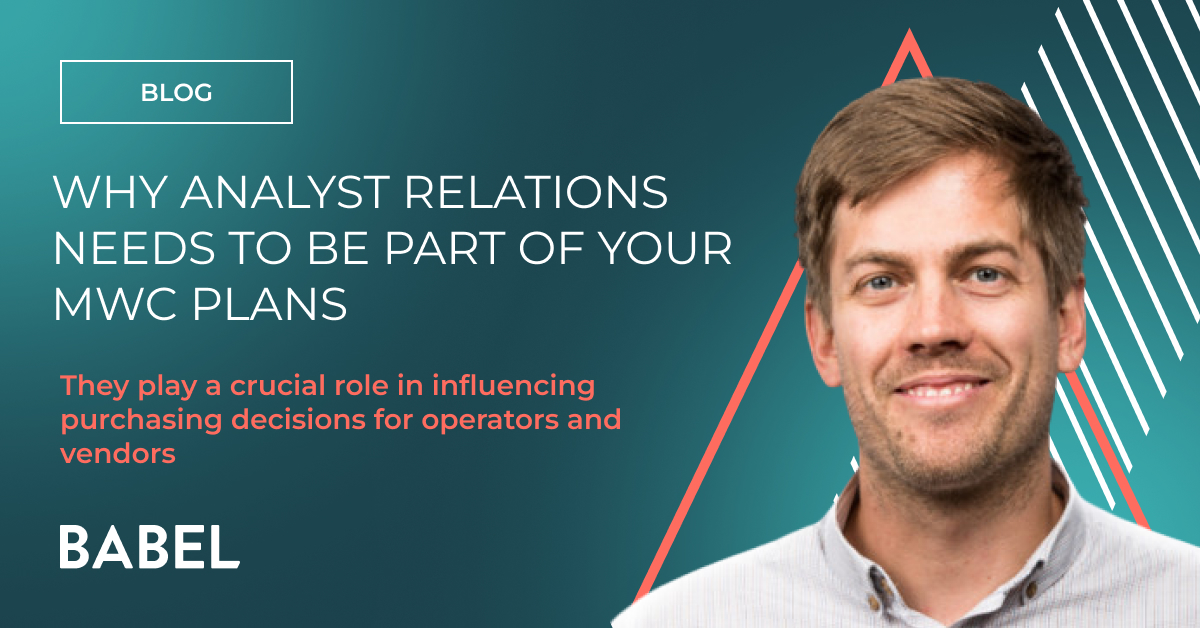Analyst relations in 2024: preparation, preferences, and predictions
When it comes to reaching out to prospective customers and building brand awareness, we all know that there are many different routes one can take with varying levels of success. And, as the economy and budgets tighten, it is vital that any communications investments are used wisely.
Babel did some research on this last year. Our B2B tech comms barometer revealed that when it comes to the most effective spheres of influence, there are some clear front runners. The single most influential channel was cited as analyst and industry reports, with 58% of IT decision-makers relying on them to help inform purchase decisions.
When looking at new products and solutions, this makes a lot of sense from a decision-maker's perspective, as impartial and well-researched insight and analysis are invaluable when weighing up major investments. But analysts' reports are even more influential in the IT tech, telco and manufacturing sectors, influencing almost two-thirds of all purchase decisions.
For the last seven years, distinguished industry analyst and expert in the digital economy Teresa Cottam has been the Chief Analyst at Omnisperience, the company she founded after nine years at the helm of Telesperience. And before all of that, she held senior analyst roles at Analysys Mason, as well as Informa and Ovum (both of which are now part of Omdia).
In addition to being renowned for helping transform businesses, Teresa is a judge of the GSMA Global Mobile Awards and the World Communication Awards, and a contributing analyst to the TM Forum. Covering telecoms software and data, her areas of interest span customer service and customer experience (including churn management, chatbots, digital support channels and call centres), monetization (billing, revenue assurance, fraud management, pricing, and packaging), as well as the application of key new technologies such as AI. Our paths have crossed a lot over the years and last month, I was delighted to speak with Teresa on the Babel Digital Communicators podcast.
Here's a recap of our conversation:
Teresa, please could you give us a bit of a background on your career to date and how you came to be an analyst in the tech and telecoms industry?
Well, I think you have done a very good job of introducing me, so I won't go over what you've already said, but I'd just like to add that I've been an analyst for almost 30 years and I often get asked how I became an analyst. The answer is that I fell into it almost by accident!
When I first started, there hadn't really been such a role for very long. A lot of the first wave of analysts came out of service providers in the telecoms industry, such as BT, or management consulting roles. One of my first jobs was with a telecoms company called Orbitel, which you probably won't remember, but was a joint venture between Racal and Plessey. Ericsson bought a 50% share in them before eventually taking them over completely. They built telecoms equipment and produced the handsets that the first SMS was sent over!
I was quite a curious young graduate, and I was fascinated by what the engineers were working on, so I asked lots of questions. At that time they were producing the first 2G equipment and it was revolutionary. Later when I went for a job at Ovum, they asked me what I knew about mobile technology, and somehow, I remembered everything I'd learnt while at Orbitel, so I got the job!
It wasn't my intention to be an analyst but I never left because it's a really interesting job. There's always something new to learn and most of the people you work with are really nice. So I suddenly find I've been doing it for almost 30 years.
When it comes to your role as an analyst, I would love to know a little bit more about how AR and PR teams can best work with you. What are your preferences for being pitched, for example?
Good analyst relations are all about picking up the phone and building relationships - this is something I am always telling young PRs. I get so many emails that it is very easy for your message to get lost in my inbox.
However, that said, I do see value in having emails that outline the stuff I need. An example of this is the email round-up that Babel does before MWC: a long list of all your clients and what they can talk about. This helps me immensely as although PRs can act as a smart filter to ensure I'm not being pitched things that are completely irrelevant, sometimes there might be something that it isn't immediately obvious why I'd be interested in that, so keeping me informed of everything in a non-obtrusive way is really helpful.
So that is a good example of how to use email effectively. But when you get the kind of volume of emails that I do, it is easy for emails to get lost in your inbox. This is where the personal relationship comes in because I am far more likely to open emails from a PR or AR I know.
There is no substitute for getting to know an analyst and spending a little bit of face-to-face time with them, and whilst I don't mind doing it over a Teams meeting, now we're able to socialise face-to-face, it's nice to get to know people a little bit better as human beings.
Building these relationships is an important investment for junior ARs and PRs. You never know when you might need an analyst on speed dial for a client. And similarly, if I need something urgently - like a quote for example - I will go to the ARs and PRs that I'm connected with and who I trust can get me a briefing quickly.
I cannot emphasise enough: all these human relationships are critically important. So, to young people starting out, I would say invest in building your network, make sure that you never burn any bridges, and keep in touch with people because it is a very small industry and you will encounter people over and over again throughout your career. Even if you stop working with one client, stay in touch with your contacts because there's a good chance in a few weeks, months, or years, you will be working with a new company where those relationships will come in handy. Keep the relationship ticking over.
How should a company prepare for a briefing with you?
Well, it is all about prep. I think one of the most frustrating things is when you go into a briefing and the client really doesn't know anything about you and doesn't really know what they want to say to you as a result. On top of that, they then announce they have 150 slides to take you through. Nobody likes 'Death by PowerPoint.' When that happens, your heart just sinks and you think, in this day and age, you really need to get to the point. This means figuring out what you really want to get out of this conversation.
It is also important to remember that there is a huge difference between talking to analysts and talking to a journalist. With me, what you're looking for is to get some space in my head. So ultimately, there are going to be two or three key messages that you want to get over, which you should say in a memorable way so that it sticks in my mind. One tip I have is to think about it like a good design: leave some white space to make the design stand out. The same is true in a briefing: don't try and cram so much in and give your key ideas room to breathe!
Importantly, make sure you leave enough time to get feedback from the analyst (if they're prepared to give it). This is really important for your client and is the start of building that relationship with them.
A good AR or PR will have this covered for their client because they will be able to explain not only the best way to approach the analyst in terms of the areas they're covering but also any 'peculiarities' such as things the analyst is interested in outside work; a little bit of background on them; how they typically communicate and what to expect from them. This helps the client spokesperson immensely because it means they will be able to tune the presentation to the analyst's needs and preferences and will give them something to help them bond with the analyst. Ultimately good prep is essential to get the best out of a briefing, and here the insight a good PR or AR can bring to the table is worth its weight in gold.
Do you ever find it tricky to maintain an impartial viewpoint when you're speaking to different companies?
Remaining impartial is an important part of our job. Of course, as human beings sometimes it's difficult to do because naturally there will be some people and companies that you like or bond with more than others. But it's really important to talk to everybody - whether they're big or small and whether you like the individual or company, or not. You have to give everybody a fair hearing, and if you can't do that, then you really can't be an analyst.
You do see instances where analysts 'go native': they will go on briefings from vendors and come back talking like the vendor. You can see their eyes going round in circles, like the snake from Jungle Book. But if that happens, they will lose credibility. We are paid to be professional sceptics and to not be biased by our personal likes and dislikes. We have to be fair. And as hard as that can be, it's an essential component of our job.
You should expect us to challenge your clients and try to put objections to them, not just to agree with everything they say. That's an important thing to warn a client about because you want to hear these objections so you can refine the pitch and think about the issues that have been raised. If an analyst is raising these issues with you, then you can bet a buyer would be thinking something similar.
What are common misconceptions when it comes to analyst relations versus media relations?
Both careers - industry analysis and journalism - have changed so much over the years, and they are jobs that will continue to evolve. At the moment, there is a fair bit of overlap between journalists and analysts. For example, you will find a lot of analysts write blogs or posts on LinkedIn, so perhaps we're looking for more current stories than we used to, but we're not in the business of breaking stories - we have to be able to maintain confidentiality or we won't last long as an analyst.
In that respect, you can tell an analyst things that you wouldn't tell a journalist, as long as you let the analyst know that a topic is confidential!
Journalists on the other hand can't be trusted in the same way with confidential information. It's the nature of their job to break exciting stories, and so there's always a pressure to come up with the goods and be the first to break the news. A reputable journalist will respect embargoes on news, but you might want to get them to sign an NDA if you intend to share confidential information (which they may decline to sign which means you will have to tailor what you tell them).
In the same way that analysts overlap with the editorial space of journalists, you get some senior journalists who have done the job for a long time and can offer a huge amount of insight into the markets they cover. While there are a lot of differences between our jobs, there is an overlap, and I don't think you should see a hard divide between the two.
Having a completely separate programme for analysts doesn't seem to reflect the reality of our jobs and, in any case, we usually know all the trade press in any case. If you handle the two completely separately, analysts might not get sent press releases or be invited to events you run for journalists. I think that's a mistake because most analysts do need to keep up with the news even if they don't write about it immediately.
As I've said, a good AR or PR will act as an intelligent filter. The most valuable thing you could do for me is to know when to bring a story to me and say, �Teresa, I thought this was interesting,� and explain how the story might be relevant to me. Equally, they know when the story's not one to flag because it is not in my area of interest.
That said, an analyst's focus and interest do change over time so it is important to keep talking to them to find out if their position or focus has changed. There may be things that are relevant today that wouldn't have been relevant before and you don't want to miss those opportunities.
What can be expected in terms of a typical outcome from an analyst briefing?
Every analyst is different, which means the outcomes can vary. Some analysts compare system features, asking lots of questions about what is the latest with the company; what is unique about the company's product or service, and so on. Other analysts may work more strategically and look at how an industry or topic is likely to evolve, what the drivers are, the pitfalls and the opportunities. Some analysts only work with numbers, producing forecasts for example.
Personally, I work a lot on emerging technology and how it is going to affect telecoms service providers. Sometimes that is delivering a new solution to an old problem, and sometimes it is completely new technology that will enable something new.
When it comes to analyst briefings, individual analysts have different styles and preferences. Some analysts will sit in silence and not say anything to you. I like to be quite interactive, so you should expect to get some feedback - both positive and critical - but even most importantly, food for thought.
One thing to address is the expectation, which comes over from PR, that the outcome of any briefing is column inches, and if a company isn't written about immediately, they may think they've failed to influence an analyst. The thing is, as I alluded to earlier, a lot of 'analyst relations' is about getting into an analyst's head. When I go into a meeting with one of your prospective customers, I will often get asked if I know a vendor that does XYZ, and that's the exact point when your investment in that briefing really comes to the fore - because that's when I will provide my recommendations based on the conversations (briefings!) I've had. Similarly, getting into an analyst report is about making that relationship months ahead of when the report gets written.
So, in summary, the outcome of an analyst briefing is almost always invisible initially. But it is definitely an outcome you want to have, rather than just having a story written about you.
That said, I enjoy writing and I might write about the company in a report later down the line, or I might write an article with a mention of your client - but that shouldn't necessarily be expected. Take it as a bonus.
And in terms of your reports, do companies need to pay to appear in them?
Put simply, paying to appear in a report is quite unethical (the 'pay-for-praise' model). That said, analysts do have to earn a living, and we have to make revenue somehow, so it's an ongoing discussion that we have within the industry as to how to have an ethical business model.
One option is subscription services. While this ensures a regular income for the analyst house it can also be problematic, however. Sales teams may discourage analysts from saying negative things about their biggest customers, and some of the target audience may not have the budget for the report - limiting its influence.
Another common option is sponsored reports. However here it's more important than ever to maintain editorial independence or the output becomes little more than marketing literature. On the other hand, this model has the advantage of making the analysis free-to-air, which benefits smaller prospects who cannot afford subscription services and maximises the audience for the report.
Analysts are constantly exploring new business models that support both our independence and allow us to do the work we do. But at the end of the day, we do have to earn a living and we can't do everything for free.
It is important for vendors and telecoms firms to invest in analyst firms to benefit from that independent voice, or it will be lost or degrade into marketing content. Like journalism and the media: if you don't spend money once in a while on advertising, publications will go under and then you'll have nowhere to publish your news and thought leadership articles.
I strongly believe that investment in analysts needs to be sprinkled around the industry. Otherwise, we'll end up in a situation where there are only three big analyst firms that only the big vendors can afford to access, and that wouldn't be good for anybody. Many of the best analysts work in smaller firms or independently so just concentrating on three or four large firms limits the insight you'll get.
By sprinkling a bit of money into the industry, you are investing in a healthy media and analyst layer, but it is important to be clear that this shouldn't be 'tit for tat'. I cover very small vendors (which a lot of analysts don't cover!) because I think that if we don't support the smaller vendors, they will never grow to be bigger vendors. Some of the most interesting innovations brought to the market come from smaller vendors, but they often don't have the budget to spend on analysts, so won't get covered. I treat this like pro-bono work, giving back to the market in the hope that one day when they have got a bit of money, they might come and spend some of it with us, although it doesn't always work out like that. I also know that my audience want to find out what is new and what interesting new vendors are out there, so that is another reason to cover this sector.
My biggest hint and tip in this area is therefore: don't pay to be in a report because the chances are that the report isn't credible. Instead, find an ethical way of working with analysts because that way you get a strong, healthy external voice which helps build a more buoyant industry.
May I ask you about the tech that is exciting you, and your predictions for 2024?
Well, I think one of the reasons I've stayed in telecoms for as long as I have is because every time I think I'm bored and there's nothing going to happen, there's another twist and a turn, and something exciting happens!
I think we would all have to be completely oblivious not to realise that last year was the 'year of AI.' Everyone was talking about AI - a bit like they did the year before about 5G - as a 'buzz topic'.
But adopting AI in telecoms is not as simple or straightforward as you may have been led to believe by some of the marketing. As I think you know, I do some work for the TM Forum, and that's something where they've worked really hard over the last couple of years. Members have formed working groups to help come up with frameworks and governance structures, and working groups to talk about how to adopt AI safely and responsibly into telecoms. Telecoms is a very regulated industry - well, we are a critical industry, so we need to ensure we adopt new technologies safely, responsibly, and compliantly. But I think this year we're going to see big steps forward in how we incorporate AI into our processes.
Like with all new technologies, there are going to be some big themes which we will see come to the fore. One of those is security. As 'everything' gets connected online and as AI comes into the market, keeping everyone safe and giving people digital confidence is important. In telecoms, this also translates to securing the networks, cyber security, and mobile identity, and AI can help here. There's a huge opportunity in being a trusted identity provider in the telecoms space. I think that's going to be one of the jewels in our crown, that we haven't yet fully exploited but will talk a lot about over the next few years.
Another key application is in customer service and customer experience. Traditionally we haven't been great at either in the telecoms market but AI will help us make great strides by assisting in the call centre, making chatbots smarter, delivering hyper-personalisation and helping to spot patterns. At the end of the day, it is important to remember our purpose is to make the world work better for human beings. And we must remember that that is what the technology is there to do. It should not be technology for technology's sake, but to make it a better place for people to live and to enable them to do what they want to do.
Do you think AI will impact your role as an analyst?
It has already started to some extent! I mean, there are things AI cannot do, as well as things it can. With journalism, for example, if you've got a well-written press release (like the sort of thing that Babel might produce), then it doesn't really take a lot of effort to turn that into a story, and AI could quite easily do that.
On my side, some of the more basic research I could see being taken over by AI, but what AI can't do is write about things at the cutting edge and explain why they're important. AI is good at repurposing things and finding patterns, but it is not truly creative in that sense.
I've been somewhat assured by my daughter, who is currently studying journalism at university that she was informed by her professor that an ICT analyst is a future-proof job. So maybe I'll keep my job for a few years yet!
But I think the risk is that young people will not be doing those basic entry-level jobs which traditionally helped to educate them and help them gain experience. It's the same in journalism, if entry-level roles are not there because you've got an AI writing up press releases for you, where will the future journalists come from?
It means that people like myself, who have been doing this for a long time, will continue to have a job. But how will we get young people to join the industry, get them up to speed, and get them to have the experience so they can take over when we're ready to put our feet up?
So it's in my own interest to try to help these young people get into the industry and get that level of expertise as I do want to retire at some point!
Teresa, thank you so much for joining me. It has been lovely to chat with you!








